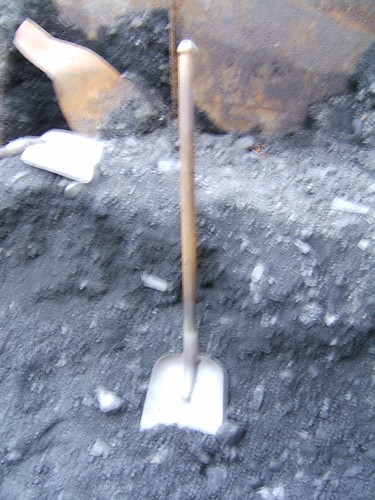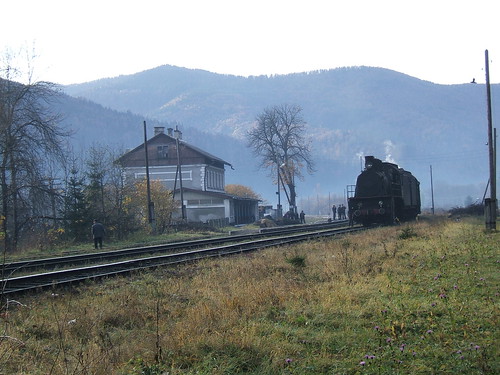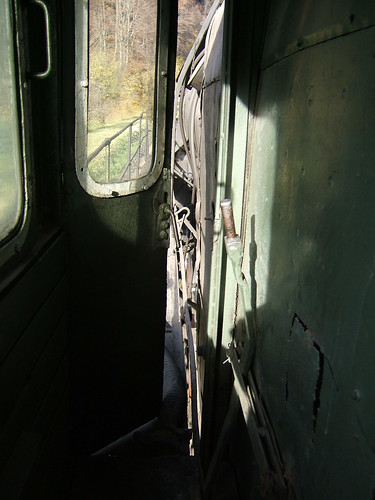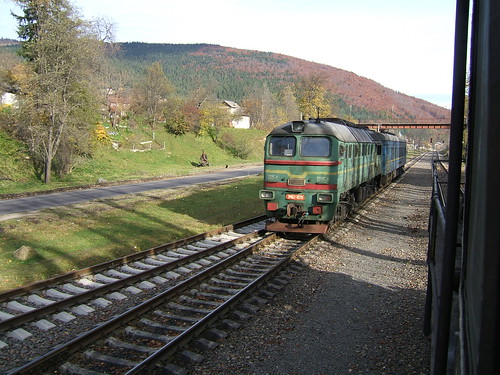On Thursday 27th October 2005, the format of the day was similar but this time the run was terminated at Mikulichin.
Into the Mountains again
As before, Er797-86 was leading from Kolomiya with Em735-72 tender first. This time, our train comprised a bogie hopper wagon, a bogie flat wagon and one of the two green coaches Su251-86 had brought from Chernivtsi. The trip the previous day had given us a little 'route knowledge' and were able to start to anticipate.
We made our way through Delyatin and Yaremcha and continued our climb as far as Mikulichin.
 Yaremcha station building.
Yaremcha station building.
 View ahead from Em 735-72 leaving Yaremcha.
View ahead from Em 735-72 leaving Yaremcha.
I commented about the poor quality of coal in Part 4. As time went on, the situation got worse as all the loose coal became used. We spent some time in the tender with shovels breaking-up the concrete-like contects, trying to release coal which stood a chance of burning. I never really got used to the firing shovels in use. Rather than the 'T' handle of English shovels, where you can use the palm of your hand to either drive the shovel blade into the coal stack or propel a shovelful to the front of the firebox, the Ukraine shovels had a long, straight handle which I found difficult to use.

Typical firing shovel.
 Em 735-72 being fired.
Em 735-72 being fired.
On arrival at Mikulichin, we ran the engines round the train ready for the return journey. There was time for me to take more pictures around the station and our train before we set off back to Kolomiya.
 Our train at Mikulichin, ready to return to Kolomiya
Our train at Mikulichin, ready to return to Kolomiya
On the return journey, the group with Mike and I was once again on the lead engine, Em 735-72, taking it in turns to drive.

Em 735-72: Fireman's view ahead. The door giving access to the foot-framing is partly open.
At Yaremcha, we passed a 2M62-class diesel electric with a single coach, which I thought might be a dormitory coach for track workers. At one point, when I was driving, we passed a group of track workers, standing clear. We solemnly saluted one another and it reminded me that the unspoken comradeship between railwaymen is not peculiar to the English.
 Passing 2M62-1070 with a single coach near Yaremcha.
Passing 2M62-1070 with a single coach near Yaremcha.
This was the fourth day that steam trains had been seen on the Rakhov line and I had started to notice how many people in the lineside properties were outside as we passed, watching the train go by, just as in England when steam specials appear on the main line.
I was driving as we approached the junction at Kolomiya where the line from Ivano Francovsk converged on our left. I looked out for our colour light signal which was showing 'off' but with a 'Green Bar' lit. I realised that we were being crossed into the 'loop' platform and shut off in plenty of time. We clattered over the points leading to the 'loop' and drifted along the platform, with only light braking needed to stop where the Ukrainian driver indicated.
And so our steam driving experience in Ukraine had come to an end. Not all of the arrangements had worked out during the week but I still found it a wonderful experience. We sadly said our "goodbyes" to our Ukranian railway friends, checked out of our hotel and were taken by coach back to Ivano Francovsk. We had a short time to look around the town before entering the railway station to catch our overnight train to Kiev. This time, my booking arrangements worked and I had a 4-berth compartment to myself.
 My 4-berth compartment on the Kiev train.
My 4-berth compartment on the Kiev train.
On arrival in Kiev, we were to visit two railway repair works (described here) and spend a night in a hotel before flying home.
Russian Railway background
At the time of my visit to Ukraine in 2005, I was almost completely ignorant about Russian Railway practice. The book 'Soviet Locomotive Types - The Union Legacy' (reference [1] below) is an invaluable primer on Russian steam, diesel and electric traction. Later, in 2011, a river cruise from Moscow to St. Petersburg (described in a series of posts here) gave me tantalising glimpses of railways in Russia itself. Then, in 2011, I travelled by the 'Golden Eagle' private train from Ulaan Baatar in Mongolia to Moscow (described in a series of posts here), finding out a little more about Russia's remarkable railway heritage.
Book References
[1] 'Soviet Locomotive Types - The Union Legacy' by A J Heywood & I D C Button (Frank Stenvalls Forlag) ISBN 0-9525202-0-6.
My pictures
The railways:
Ukraine Steam.
Ukraine Modern Image.
The country:
Ukraine.
